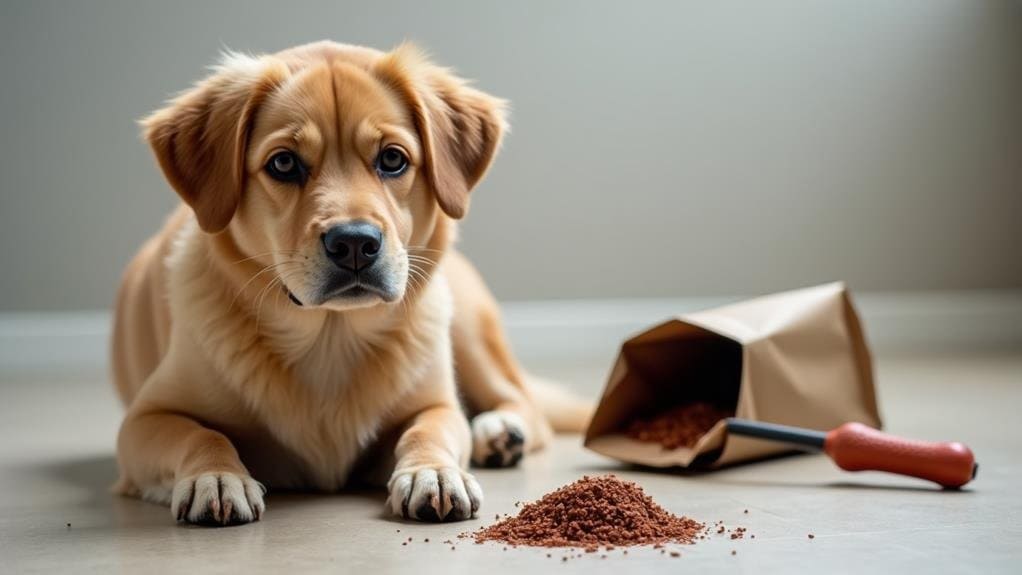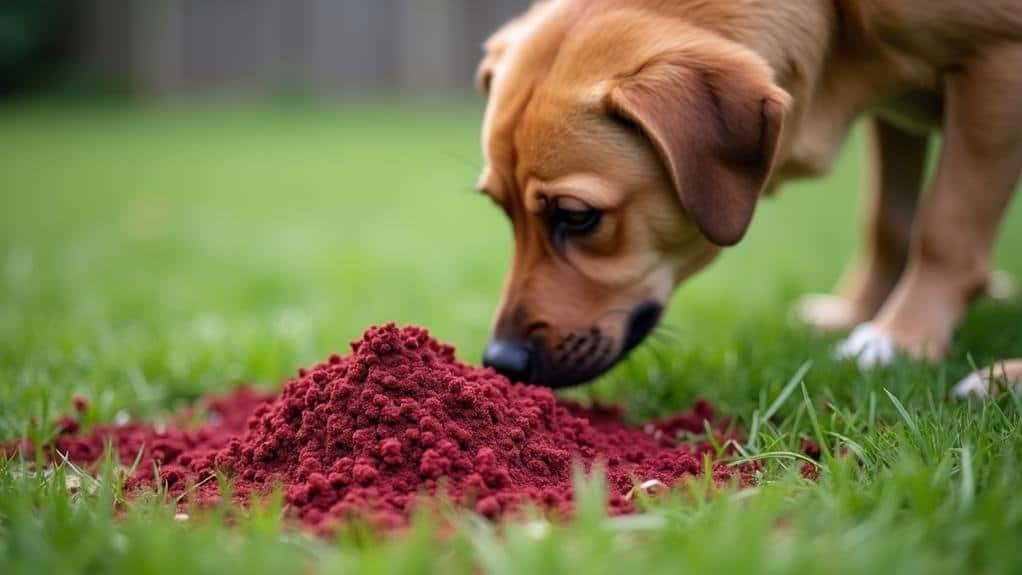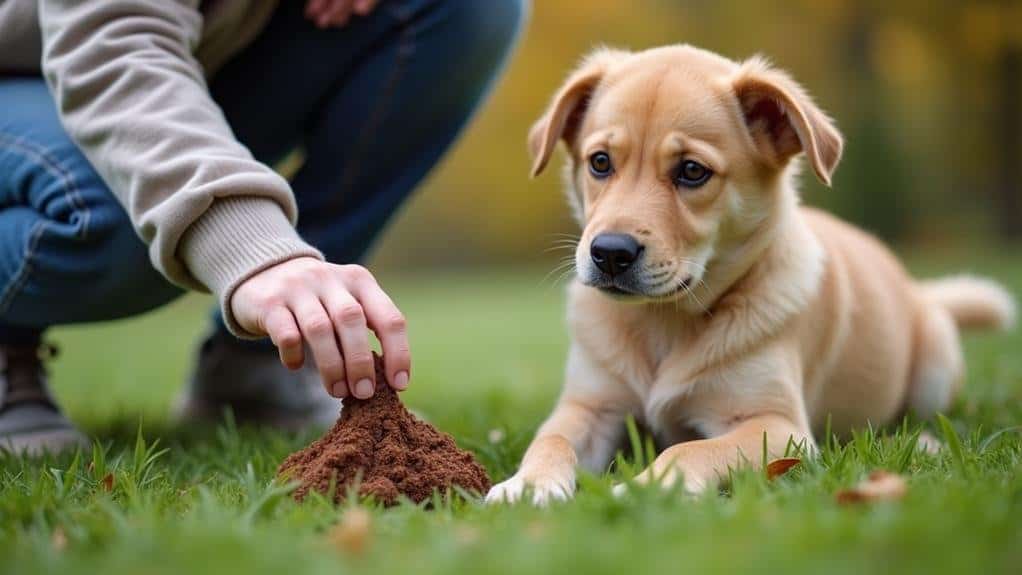If you notice blood in your dog’s stool, it’s essential to take it seriously.
The blood can appear bright red (hematochezia) from the lower digestive tract or dark and tarry (melena) from the upper tract.
Common causes include infections, parasites, dietary issues, or more severe conditions like cancer.
Watch for accompanying symptoms like vomiting, lethargy, or loss of appetite.
Contact your vet immediately, especially for puppies or if there’s a large amount of blood.
While a single streak may not be alarming, consistent bleeding requires prompt attention.
Understanding the type and potential causes of bloody stool can help you better navigate this concerning situation.
Common Causes of Bloody Stool

In light of the various causes of bloody stool in dogs, it’s vital to understand the most common culprits. Gastrointestinal issues, such as colitis, often lead to blood in stool. You might notice hematochezia, characterized by bright red blood, indicating problems in the lower digestive tract.
Alternatively, melena, or dark, tarry stools, suggests bleeding in the upper digestive tract.
Infections, both viral and bacterial, can cause bloody stool. Parvovirus is particularly dangerous for unvaccinated puppies, resulting in severe bloody diarrhea that requires immediate veterinary attention.
Inflammatory bowel disease and food intolerances are other potential causes that need thorough veterinary evaluation.
Don’t overlook the possibility of your dog ingesting harmful foreign objects or toxic substances, which can lead to internal damage and bloody stool.
It’s imperative to monitor accompanying symptoms like vomiting, lethargy, or loss of appetite, as these may indicate more severe underlying conditions.
If you notice blood in your dog’s stool, don’t hesitate to seek professional help. A prompt veterinary evaluation can identify the root cause and guarantee appropriate treatment, potentially preventing more serious complications.
Types of Blood in Dog Feces

Recognition of different types of blood in dog feces is vital for effective diagnosis and treatment. As a dog owner, you’ll need to distinguish between two main types: hematochezia and melena.
Hematochezia appears as bright red blood in your dog’s stool, indicating issues in the lower digestive tract. This may result from conditions like colitis or rectal injury. On the other hand, melena manifests as dark, tarry stools due to digested blood, suggesting problems in the upper digestive tract such as ulcers or tumors.
While a single streak of bright red blood may not always indicate serious health concerns, consistent or large amounts warrant immediate veterinary attention. Both hematochezia and melena can stem from various underlying issues, including infections, parasites, dietary indiscretion, and even cancer.
Accurate diagnosis is essential for your dog’s gastrointestinal health, as the type of blood present guides veterinarians in determining the appropriate treatment plan. By observing and reporting the nature of the blood in your dog’s feces, you’re providing valuable information that can help pinpoint the source of the problem and guarantee timely, effective treatment.
Recognizing Symptoms and Warning Signs

While blood in your dog’s stool is alarming, it’s vital to recognize accompanying symptoms and warning signs that may indicate a more serious condition. If you notice blood in your dog’s stool, pay close attention to its appearance. Bright red blood suggests lower digestive tract issues, while dark, tarry stools point to upper digestive tract problems.
Keep an eye out for other symptoms that could signal an emergency. Vomiting, lethargy, or refusal to eat are red flags that shouldn’t be ignored. Signs of dehydration, such as sunken eyes or dry gums, require immediate veterinary attention.
If you observe consistent or large amounts of blood in the stool, rather than a single streak, it’s important to seek professional help promptly.
Monitor changes in your dog’s stool color and consistency, as well as their overall behavior. These observations can provide valuable information to your veterinarian and help determine the underlying cause of the bloody stool.
Immediate Actions for Pet Owners

Upon discovering blood in your dog’s stool, it’s crucial to take immediate action. Your first step should be to contact your veterinarian right away. They’ll assess the situation and guide you on the necessary next steps, which may include an emergency visit.
While waiting for professional advice, closely monitor your dog’s condition. Watch for signs of vomiting, lethargy, or loss of appetite, as these could indicate a more serious health issue requiring urgent care.
If your dog is a young puppy, don’t hesitate to seek immediate veterinary attention, as blood in stool can be a symptom of potentially fatal conditions like parvovirus.
Examine the stool’s appearance carefully. Bright red blood (hematochezia) suggests lower digestive tract problems, while dark, tarry stools (melena) indicate upper digestive issues. This information will be valuable for your vet’s diagnosis.
Veterinary Diagnosis and Treatment Options

When your dog arrives at the veterinary clinic, the diagnostic process begins with a thorough physical examination. Your vet will perform rectal checks and may order diagnostic tests like fecal examinations and blood work to identify the underlying cause of the bloody stool.
Imaging techniques, such as X-rays or ultrasounds, might be used to check for foreign bodies or tumors, while endoscopy can provide direct visualization of the gastrointestinal tract.
Treatment options vary widely depending on the cause. For mild conditions, your vet may recommend dietary changes or medications. In severe cases, surgical interventions might be necessary to address issues like intestinal blockages or tumors.
Dehydration management is vital, and your vet may administer subcutaneous or intravenous fluids to restore your dog’s hydration levels.
Early intervention is essential when it comes to bloody stool. By seeking veterinary care promptly, you’ll greatly improve your dog’s chances of a positive outcome and prevent potential complications.
Frequently Asked Questions
Why Is My Dog Pooping Blood but Acting Fine?
Your dog’s bloody stool might be due to minor issues like dietary indiscretion or mild colitis. While they’re acting normal, it’s still concerning. You should monitor their behavior closely and consult a vet to rule out serious conditions.
Can Blood in Dog Stool Go Away on Its Own?
While minor cases of blood in your dog’s stool might resolve on their own, it’s not something you should ignore. You shouldn’t wait for it to go away, as it could indicate serious health issues requiring veterinary attention.
What Infection Causes Dogs to Poop Blood?
Several infections can cause your dog to poop blood. You’ll want to watch for parvovirus, bacterial infections like Salmonella, and viral gastroenteritis. Hemorrhagic gastroenteritis is also a concern. Don’t forget about intestinal parasites like hookworms and whipworms.
Is a Dog Pooping Blood an Emergency?
Yes, it’s often an emergency. You should take your dog to the vet immediately if you notice blood in their stool. It can indicate serious conditions, especially if accompanied by other symptoms. Don’t wait; prompt action is essential.
Conclusion
You’ve learned about the causes, types, and symptoms of bloody stools in dogs. Don’t ignore this serious issue.
If you notice blood in your dog’s poop, act quickly. Contact your vet immediately and provide as much information as possible.
Remember, early intervention can make a big difference in your pet’s health.
By staying vigilant and taking prompt action, you’ll be better equipped to handle this potentially dangerous situation and guarantee your furry friend’s well-being.

